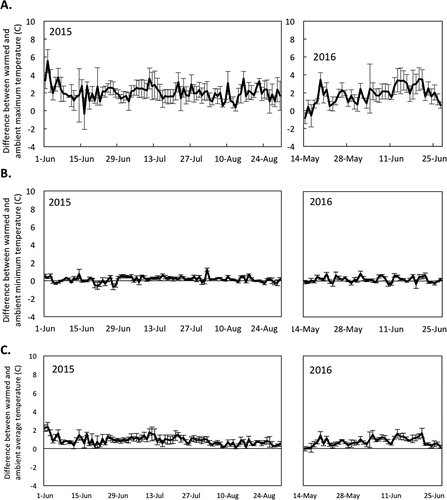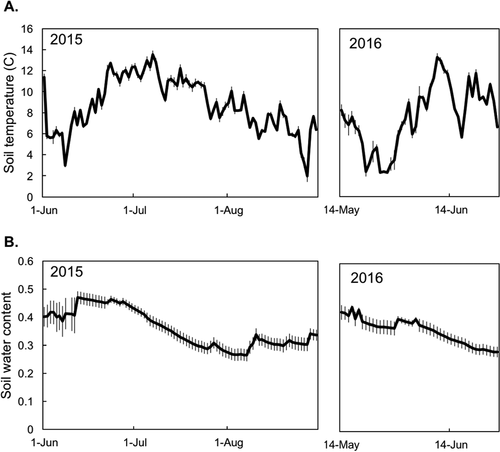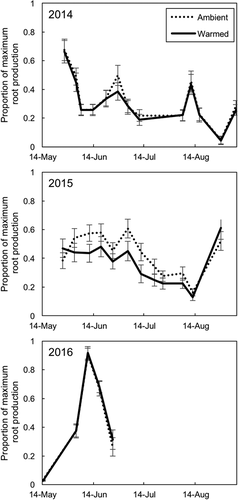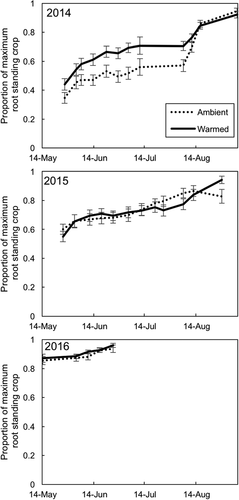Figures & data
Figure 1. (A) The difference between daily maximum air temperature in warmed plots and daily maximum temperature in ambient plots (°C). (B) The difference between daily minimum air temperature in warmed plots and daily minimum temperature in ambient plots (°C). (C) The difference between daily mean air temperature in warmed plots and daily mean temperature in ambient plots (°C). In all panels, values are averaged across all vegetation types. On average across all years and vegetation types, open-top chambers warmed maximum daily temperatures by 2.2 ± 0.6°C (model estimate ± SE) and mean daily temperatures by 0.9 ± 0.2°C (model estimate ± SE). Warming had little effect on minimum daily temperature. Error bars represent standard error of the mean. N = 6 per warming treatment

Table 1. Continuous abiotic measurements recorded hourly from CR-1000 dataloggers in twelve plots (n = 2 per warming by vegetation type), separated by warming treatment. Values represent mean ± standard error of the mean of raw data
Figure 2. (A) Mean daily air temperature in graminoid (Poa spp.) plots from 2015 to 2016 in warmed and ambient treatments. Values are separated by warming treatment. Temperatures in warmed plots were 1.5 ± 0.3°C higher than in ambient plots (model estimate ± SE). (B) Mean daily air temperature in mixed plots (half Poa spp. and half Betula nana) from 2015 to 2016 in warmed and ambient treatments. Temperatures in warmed plots were 0.2 ± 0.09°C higher than in ambient plots (model estimate ± SE). (C) Mean daily air temperature in shrub plots (Betula nana) from 2015 to 2016 in warmed and ambient treatments. Temperatures in warmed plots were only marginally increased (temperature increase of 0.6 ± 0.3°C [model estimate ± SE]). In all panels, the gray line represents ambient plots, and the black line represents warmed plots. Error bars represent standard error of the mean. N = 2 per vegetation type by treatment
![Figure 2. (A) Mean daily air temperature in graminoid (Poa spp.) plots from 2015 to 2016 in warmed and ambient treatments. Values are separated by warming treatment. Temperatures in warmed plots were 1.5 ± 0.3°C higher than in ambient plots (model estimate ± SE). (B) Mean daily air temperature in mixed plots (half Poa spp. and half Betula nana) from 2015 to 2016 in warmed and ambient treatments. Temperatures in warmed plots were 0.2 ± 0.09°C higher than in ambient plots (model estimate ± SE). (C) Mean daily air temperature in shrub plots (Betula nana) from 2015 to 2016 in warmed and ambient treatments. Temperatures in warmed plots were only marginally increased (temperature increase of 0.6 ± 0.3°C [model estimate ± SE]). In all panels, the gray line represents ambient plots, and the black line represents warmed plots. Error bars represent standard error of the mean. N = 2 per vegetation type by treatment](/cms/asset/87376da8-56a1-4999-942e-c660d8700bf7/uaar_a_1414457_f0002_b.gif)
Figure 3. (A) Mean daily soil temperature in all plots from 2015 to 2016, as measured from continuous dataloggers. (B) Mean daily volumetric soil water content in all plots from 2015 to 2016, as measured from continuous dataloggers. In both panels, values are averaged across all treatments and vegetation types. Warmed and ambient plots were not significantly different. Error bars represent standard error of the mean (N = 12)

Table 2. Continuous abiotic measurements recorded hourly from CR-1000 dataloggers in twelve plots (n = 2 per warming by vegetation type), separated by vegetation type. Values represent mean ± standard error of the mean of raw data
Figure 4. Relative leaf cover (NDVI on a given date/maximum NDVI in that year) averaged for ambient and warmed plots in 2015 and 2016. The dashed gray line and gray points are the mean of ambient plots, and the solid black line and points are the mean of warmed plots. There was no significant effect of the warming treatment. Error bars represent standard error of the mean. N = 24 per warming treatment

Figure 5. Timing of relative new root production (root production on a given date/maximum root production in that year) in warmed and ambient plots for three growing seasons. The warming treatment did not have a significant effect on the timing of root production. The gray line and points are the mean of ambient plots, and the black line and points are the mean of warmed plots. Error bars represent standard error of the mean. N = 24 per warming treatment

Figure 6. Timing of relative root standing crop (roots present on a given date/maximum root standing crop in that year) in warmed and ambient plots for three growing seasons. The gray line and points are the mean of ambient plots, and the black line and points are the mean of warmed plots. Error bars represent standard error of the mean. N = 24 per warming treatment

